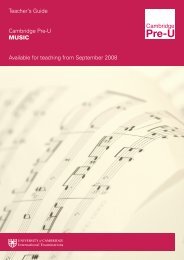Cambridge Pre-U Syllabus - Cambridge International Examinations
Cambridge Pre-U Syllabus - Cambridge International Examinations
Cambridge Pre-U Syllabus - Cambridge International Examinations
You also want an ePaper? Increase the reach of your titles
YUMPU automatically turns print PDFs into web optimized ePapers that Google loves.
<strong>Cambridge</strong> <strong>Pre</strong>-U <strong>Syllabus</strong><br />
12. (a) Suggest is used in two main contexts, i.e. either to imply that there is no unique answer (e.g. in<br />
Biology, there are a variety of factors that might limit the rate of photosynthesis in a plant in a<br />
glasshouse),<br />
(b) Suggest may also be used to imply that candidates are expected to apply their general knowledge<br />
and understanding of Biology to a ‘novel’ situation, one that may be formally ‘not in the syllabus’ –<br />
many data response and problem solving questions are of this type.<br />
13. Find is a general term that may variously be interpreted as calculate, measure, determine, etc.<br />
14. Calculate is used when a numerical answer is required. In general, working should be shown,<br />
especially where two or more steps are involved. Suitable units should be given where possible.<br />
15. Measure implies that the quantity concerned can be directly obtained from a suitable measuring<br />
instrument, e.g. length, using a rule, or mass, using a balance. Suitable units should be given where<br />
possible.<br />
16. Determine often implies that the quantity concerned cannot be measured directly but is obtained by<br />
calculation, substituting measured or known values of other quantities into a standard formula. It may<br />
also be used in the context of a procedure that needs to be carried out so that a numerical answer may<br />
be obtained. For example it may be necessary to find the energy absorbed by a plant so that its<br />
efficiency may be calculated.<br />
17. Estimate implies a reasoned order of magnitude statement or calculation of the quantity concerned,<br />
making such simplifying assumptions as may be necessary about points of principle and about the<br />
values of quantities not otherwise included in the question.<br />
18. Show is used when an algebraic deduction has to be made to prove a given equation. It is important<br />
that the algebraic symbols being used by candidates are stated explicitly.<br />
19. (a) Sketch, when applied to graph work, implies that the shape and/or position of the curve need only<br />
be qualitatively correct, but candidates should be aware that, depending on the context, some<br />
quantitative aspects may be looked for, e.g. passing through the origin, having an intercept,<br />
asymptote or discontinuity at a particular value. On a sketch graph it is essential that candidates<br />
indicate clearly what is being plotted on each axis.<br />
(b) Sketch when applied to diagrams, implies that a simple, freehand drawing is acceptable.<br />
Nevertheless, care should be taken over proportions and the clear exposition of important details.<br />
20. Compare requires candidates to provide both the similarities and differences between things or<br />
concepts.<br />
21. Recognise is often used to identify facts, characteristics or concepts that are critical<br />
(relevant/appropriate) to the understanding of a situation, event, process or phenomenon.<br />
22. Classify requires candidates to group things based on common characteristics.<br />
In all questions, the number of marks allocated are shown on the examination paper and should be used as<br />
a guide by candidates to how much detail to give. In describing a process, the mark allocation should give<br />
the candidate an indication as to how many steps to include. In explaining why something happens, it gives<br />
the candidate an indication as to how many reasons to give, or how much detail to give for each reason.<br />
67

















